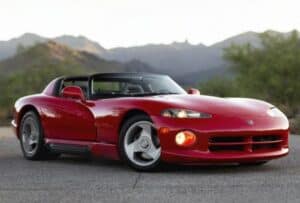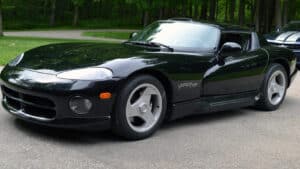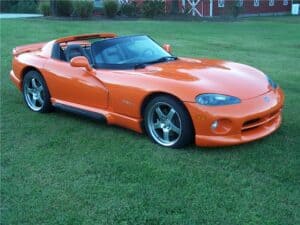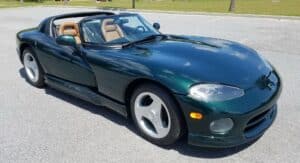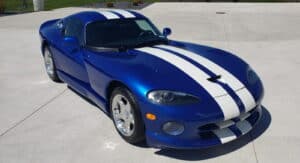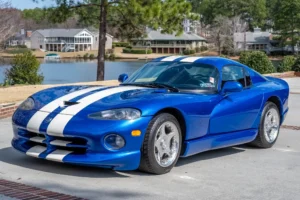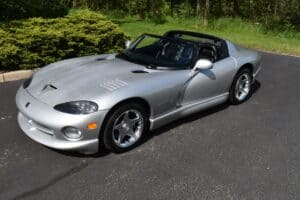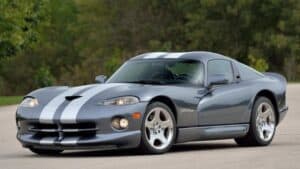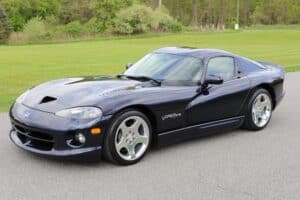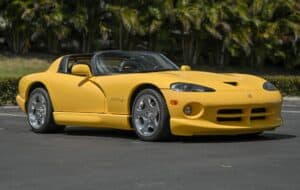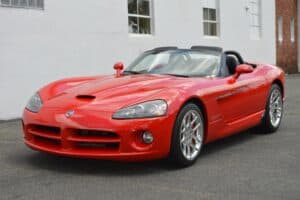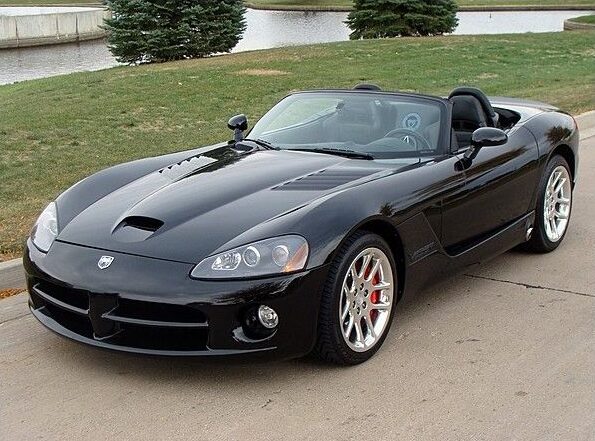The Dodge Viper is a V10-powered sports car manufactured by the Dodge division of Chrysler LLC. Production of the two seat sports car began at New Mack Assembly in 1992 and moved to its current home at Conner Avenue Assembly in October 1995. The car, as well as numerous variations of it, has made countless appearances in TV shows, video games, movies, and music videos.
The Viper was initially conceived in late 1988 at Chrysler’s Advanced Design Studios. The following February, Chrysler president Bob Lutz suggested to Tom Gale at Chrysler Design that the company should consider producing a modern Cobra, and a clay model was presented to Lutz a few months later. The car appeared as a concept at the North American International Auto Show in 1989. This concept vehicle was originally named Copperhead because of its low, wide appearance characteristic of reptiles. All engines for the Viper have since been known as “copperhead”. The name would later be changed to Viper. Public reaction was so enthusiastic, that chief engineer Roy Sjeoberg was directed to develop it as a standard production vehicle.
Sjoberg selected 85 engineers to be “Team Viper”, with development beginning in March 1989. The team asked the then-Chrysler subsidiary Lamborghini to cast some prototype aluminum blocks based on Dodge’s V10 truck engine for sports car use in May. The production body was completed in the fall, with a chassis prototype running in December. Though a V8 was first used in the test mule, the V10, which the production car was meant to use, was ready in February 1990.
Official approval from Chrysler chairman Lee Iacocca came in May 1990. One year later, Carroll Shelby piloted a pre-production car as the pace vehicle in the Indianapolis 500 race. In November 1991, the car was released to reviewers with first retail shipments beginning in January 1992.
The centerpiece of the car was its engine. It was based on the Chrysler LA design, which was a truck engine. The original configuration made it too heavy for sports car use, so Lamborghini, then owned by Chrysler Corporation, revamped Dodge’s cast-iron block V10 for the Viper by recasting the block and head in aluminum alloy. Some within Chrysler felt the pushrod two-valve design, while adequate for the truck application, was unsuitable for a performance car and suggested a more comprehensive redesign which would have included four valves per cylinder. Chrysler, however, was uncertain about the Viper’s production costs and sales potential and so declined to provide the budget for the modification.
The engine weighed 711 lb and produced 400 hp at 4600 rpm and 465 lb·ft of torque at 3600 rpm, and thanks to the long-gearing allowed by the engine, provided fuel economy at an EPA-rated 12 miles per US gallon city and 20 miles per US gallon highway. The body was a tubular steel frame with resin transfer molding (RTM) fiberglass panels. Some small bits of the suspension, (tie-rod ends and parts of the front wheel hubs) following the manufacturer’s “engine first” mantra, were sourced from the Dodge Dakota pickup. It had a curb weight of 3,280 lb and lacked all modern driver aids such as traction control or anti-lock brakes. Car and Driver magazine referred to this generation as “the world’s biggest Fat Boy Harley”, and likened driving it to “playing ping pong with a Louisville Slugger baseball bat.” Despite this, in straight line performance, it completed a quarter mile in 12.6 seconds and had a maximum speed of over 180 mph. Its large tires allowed the car to average close to 1 lateral g in corners, placing it among the elite cars of its day. However, the car proved tricky to drive at high speeds, particularly for the unskilled.
The car was spartan, although it featured inflatable lumbar support and adjustable seats. Along with the absence of exterior door handles, the vehicle lacked side windows and a roof. Although a soft top cover was available, it was designed primarily for outdoor vehicle storage. Side curtains of fabric and clear plastic operated by zippers could be inserted into the door and hand-bolted when needed. All of these decisions were made to reduce weight. The battery is located in the sealed compartment over the rear wheel well to increase rear-end weight and traction. The car shipped with a tonneau cover and video tape on soft-top assembly (the soft top is removable and folds to fit in the trunk). In 1994 A/C was added as an option.
A coupe model called the GTS was also introduced in 1996. Dubbed “dubble bubble”, the roof featured slightly raised sections above each seat to accommodate usage of helmets, a throwback to its intended purpose. Indeed, the Viper’s performance has made the vehicle popular for both amateur and professional racers. Vipers can be seen participating often in drag racing, road racing and drifting. The GTS, like its predecessor, was chosen as the pace car for the 1996 Indianapolis 500.
Despite its similar outward appearance, the car was distinct enough to be considered a new generation model. Extensive modifications such as a reworked engine with higher power and less weight, an almost completely redesigned chassis that was made 60 lb lighter and 25% stiffer in torsional rigidity through meticulous computer analysis, a thoroughly redesigned suspension, and reduced braking distances; the 1996 to 2002 Viper GTS had a lighter (approximately 650 lb) 450 bhp engine, which could complete the quarter mile 0.3 seconds and 8 mph faster, and increased top speed by 11 mph or so. The revised suspension, stiffer chassis, and aerodynamic body raised lateral grip to 0.98 g, although other reports show the 1992 model with 1.0 g. Contemporary tires have improved upon this measure significantly. Slalom runs could often reach or exceed 70 mph. Brakes once again lacked ABS initially, and proved to be the car’s weakest point. The brakes cost the car in numerous comparison tests, such as a 1997 “supercar comparison” by Motortrend, in which the Viper GTS placed at the top against cars such as the Ferrari 550, Chevrolet Corvette, Porsche 911, and Honda NSX in all performance exercises except braking. The car not only placed last, but had considerably longer stopping distances than other vehicles. ABS was introduced further into the production run, though braking performance was not necessarily significantly improved. In a Sports Car International comparison conducted in 2002, the Viper ACR (with ABS) was compared to the 911 GT2 at Thunderhill Raceway Park. Both cars were very capable, and quick around the test track, but the Viper proved more difficult to drive, and the braking system was blamed very specifically for the gap in lap times (approximately GT2: 2 minutes, ACR: 2:04) between the two cars.
Along with the updated performance came the inclusion of some of the “luxuries” the car did without before. Dual front airbags were added to the vehicle’s safety equipment list in 1996 on the GTS and 1997 on the R/T10 as mandated by the government. The car was also exported to Europe, where it was rebadged as a Chrysler, and sold under this marque from 1997 to 2003. European models had a detuned version of the Copperhead V10.
In the first six years of production almost 10,000 Vipers were sold. Minor evolutionary changes including new 18″ diameter wheels and were introduced in the 1999 model. Subsequent versions featured light-weight hypereutectic pistons and an improved exhaust system, side exhaust having been dropped part way through production year 1996 for the RT/10, all production GTS Viper Coupes had rear exit exhaust. 1999 saw the introduction of the Cognac Connolly interior package. Continuing the refinements, ABS was introduced in 2001. In 2002, the end of second generation production was celebrated with the release of 360 commemorative “Final Edition” models. These models were painted red with white stripes, paying tribute to the famous race-winning Oreca cars.
The Dodge Viper underwent a major redesign in 2003, courtesy of DaimlerChrysler’s Street and Racing Technology group. The new Viper SRT-10 was heavily restyled with sharp, angled bodywork. The engine’s displacement was enlarged to 8.3 L which, with other upgrades, combined to increase output to 500 hp and 525 lb·ft of torque. Along with the power increases, weight was reduced into the 500 lb range. The chassis was also improved. It became more rigid and weighed approximately 80 pounds less than the previous model. An even lighter and stronger chassis was planned, but was abandoned because of cost. It is unlikely that the cost increase would have reduced the car’s performance value, as it was already one of the fastest cars under $300,000. Parts from the planned suspension were used in the Hennessey Viper Venom 1000 Twin Turbo, however. The initial model was a convertible. In 2004, Dodge introduced a limited edition Mamba package. Mamba edition cars featured black interiors, with red stitching and trim and saw their MSRP price rise by roughly $3000. 200 Mambas were produced.
The new Viper SRT-10 Coupe was introduced in 2005, at the Detroit Auto Show, as a 2006 model. It shares many of its body panels with the convertible but takes its side and rear styling cues from the Competition Coupe. The new coupe looks much like the previous Viper GTS and retains the “double-bubble” roof shape of the original, along with the original GTS’s taillights as well offering the original Viper Blue paint scheme with white stripes (referred to as GTS Blue) for an added homage to the original Viper coupe. The engine was also certified by the SAE to produce 510 hp and 535 lb·ft of torque. It is important to note that the engine makes the same power as before, only the numerical value of the power was changed. Unlike the original coupe, the chassis was not modified. This made the new coupe heavier than the convertible, and thus slightly slower in low speed acceleration. Handling and high speed performance were improved by the coupe’s stiffer frame, reduced drag, and increased downforce.
No 2007 model Vipers were produced. Instead, Chrysler chose to give the 2006 model an extended run while preparing the updated 2008 model.
In 2008, with the introduction of the 8.4 L V10, the Viper received a 90 hp bump up to 600 hp, a 25 lb·ft torque bump up to 560 lb·ft and the engine displacement was increased up to 510.0 cubic inches from 505.6 CID of the 8.3 L engine, also receiving better flowing heads with larger valves, Mechadyne cam-in-cam variable valve timing on the exhaust cam lobes, and dual electronic throttle bodies. The rev limit was able to be increased by 300 rpm due to the improved valve-train stability from both the new camshaft profiles and valve-springs. The development of the engine was done with some external assistance from McLaren Automotive and Ricardo Consulting Engineers. Electronic engine control is developed by Continental AG, the controller is capable of monitoring the crankshaft and cylinder position up to six times during each firing and has 10 times more processing power compared to the previous unit.
Changes outside of the engine were less extreme, but still influential. The Tremec T56 transmission has been replaced with a new Tremec TR6060 which now has triple first gear synchronizers and doubles for higher gears. Shifts are claimed to be 18% quicker than the 2006-2007 Chevrolet Corvette Z06. The Dana M44-4 rear axle from the 2003-2006 model now has a GKN ViscoLok speed-sensing limited-slip differential that greatly helps the tires in getting grip under acceleration. Another performance upgrade was the removal of run-flat tires; the new Michelin Pilot Sport 2 tires have increased driver feedback as well as grip and, along with revised suspension (springs, anti-roll bars, and shock valving), has made the Viper more neutral in cornering.
The modifications made to the 2008 model year car were enough for Chrysler to make it distinct from the first SRT-10, and the 2008 model became known as Gen IV, just in time for release with Chevrolet’s 620 hp Corvette ZR1. Another notable change is the reworking of the exhaust system, previous third generation Vipers had their exhaust crossover under the seats which resulted in a large amount of heat going into the cockpit, this was done initially to help improve the cars exhaust note, since the first 2 generations of Viper, which had no crossover, were criticized for their lackluster exhaust notes. For 2008, the Viper exhaust will utilize a new exhaust system with no crossover, reducing the heat that enters the cockpit, but allowing the Viper to still produce an exotic sound.
Car and Driver recently tested the car and got a 0-60 mph time of 3.5 seconds, a 0-100 mph time of 7.6 seconds and a Quarter Mile-time of 11.5 seconds at 126 mph. Dodge’s claims for top speed are 197 mph and 202 mph, for the Roadster and Coupe respectively. Car and Driver also tested the Viper’s track performance, and managed a fast sub 3 minute lap time around Virginia International Raceway. The Viper’s time, despite hot weather, was faster than the Corvette Z06, Ford GT, Porsche 911 Turbo and 911 GT3, Audi R8, and other such cars. According to Car and Driver and Motor Trend, the car’s slightly adjusted suspension setup and new differential gave it cornering ability as sharp as before with even better control, feedback, and response.
1992 Viper |
|||||||||||||||||||||||||
|
|
|||||||||||||||||||||||||
|
|||||||||||||||||||||||||
1993 Viper |
|||||||||||||||||||||||||
|
|
|||||||||||||||||||||||||
|
|||||||||||||||||||||||||
1994 Viper |
|||||||||||||||||||||||||
|
|
|||||||||||||||||||||||||
|
|||||||||||||||||||||||||
1995 Viper |
|||||||||||||||||||||||||
|
|
|||||||||||||||||||||||||
|
|||||||||||||||||||||||||
1996 Viper |
|||||||||||||||||||||||||
|
|
|||||||||||||||||||||||||
|
|||||||||||||||||||||||||
1997 Viper |
|||||||||||||||||||||||||
|
|
|||||||||||||||||||||||||
|
|||||||||||||||||||||||||
1998 Viper |
|||||||||||||||||||||||||
|
|
|||||||||||||||||||||||||
|
|||||||||||||||||||||||||
1999 Viper |
|||||||||||||||||||||||||
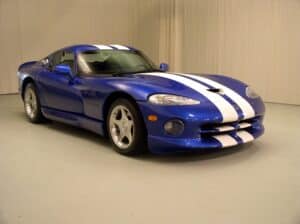 |
|||||||||||||||||||||||||
|
|||||||||||||||||||||||||
2000 Viper |
|||||||||||||||||||||||||
|
|
|||||||||||||||||||||||||
|
|||||||||||||||||||||||||
2001 Viper |
|||||||||||||||||||||||||
|
|
|||||||||||||||||||||||||
|
|||||||||||||||||||||||||
2002 Viper |
|||||||||||||||||||||||||
|
|
|||||||||||||||||||||||||
|
|||||||||||||||||||||||||
2003 Viper |
|||||||||||||||||||||||||
|
|
|||||||||||||||||||||||||
|
|||||||||||||||||||||||||
2004 Viper |
|||||||||||||||||||||||||
|
|
|||||||||||||||||||||||||
|
|||||||||||||||||||||||||
2005 Viper |
|||||||||||||||||||||||||
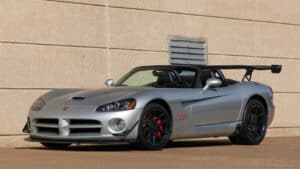 |
|||||||||||||||||||||||||
|
|||||||||||||||||||||||||
2006 Viper |
|||||||||||||||||||||||||
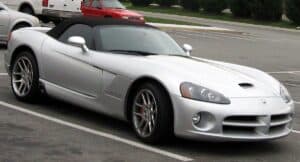 |
|||||||||||||||||||||||||
|
|||||||||||||||||||||||||
2007 Viper |
|||||||||||||||||||||||||
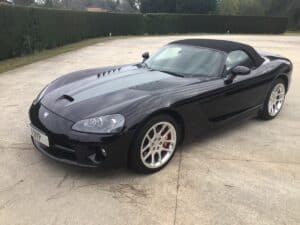 |
|||||||||||||||||||||||||
|
|||||||||||||||||||||||||
2008 Viper |
|||||||||||||||||||||||||
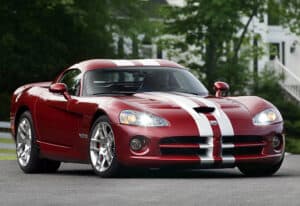 |
|||||||||||||||||||||||||
|
|||||||||||||||||||||||||
2009 Viper |
|||||||||||||||||||||||||
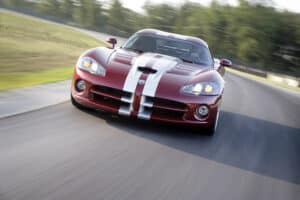 |
|||||||||||||||||||||||||


